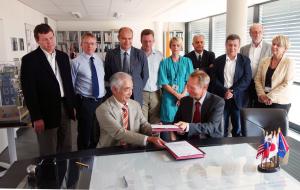Another fruitful week for signatures
7 Oct 2013
ITER Director-General Motojima signed two Procurement Arrangements late September with Henrik Bindslev, director of the European Domestic Agency Fusion for Energy.
The latest gathering of the project's Unique ITER Team late September was also the occasion for the signature of two Procurement Arrangements with the European Domestic Agency.
The first Procurement Arrangement covers the distribution system of hot gas for the regeneration of the vacuum system cryopumps. "The signature of the Warm Regeneration Line Procurement Arrangement is a momentous occasion for us," stated ITER Vacuum Section Leader Robert Pearce after the signature, "as it is the first of five Procurement Arrangements for vacuum equipment that will be signed with Europe.
"It is our smallest value Procurement Arrangement," explained Technical Responsible Officer Igor Sekachev, "but it comes as result of significant design effort and much negotiation between the ITER Organization and European Domestic Agency teams."
The new ITER Technical Responsible Officer for the Procurement Arrangement, Shaun Hughes, explained how the system will work: "ITER will have 12 very large cryopumps distributed around the machine and the neutral beam injectors. Normally, these run at very low temperatures (4.5K) to effectively pump all the different types of gases in vacuums. But to remove different types of gases from the pumps, different temperatures will be required. The warm regeneration lines will distribute helium at temperatures of between -200 ºC and + 200 ºC to all the cryopumps to allow all pumped gases from the vacuum system to be released and processed."
It is expected that the warm regeneration lines will be one of the first distributed systems to be installed in the Tokamak Building in 2017.
The second Procurement Arrangement, for the design of ITER's radiological and environmental monitoring system (REMS), is under the responsibility of the Tritium Plant Section. As the name of the package suggests, most of the system is needed after First Plasma and in preparation for nuclear operation.
However, the system also includes beryllium monitoring and instruments like the stack monitors or x-ray monitors for certain parts of ITER which will already be required for First Plasma. The procurement package has thus been split into two parts: first, further detailing of REMS requirements and the execution of preliminary and final design; and later REMS hardware (which will be signed at a later date).
"Cost containment is very important if fusion is to become a competitive energy source," Henrik Bindslev, director of the European Domestic Agency, reminded those present. "Value engineering, therefore, must be continued in all areas."


